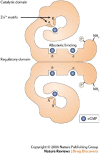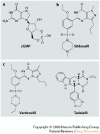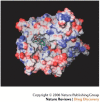Sildenafil: from angina to erectile dysfunction to pulmonary hypertension and beyond
- PMID: 16883306
- PMCID: PMC7097805
- DOI: 10.1038/nrd2030
Sildenafil: from angina to erectile dysfunction to pulmonary hypertension and beyond
Abstract
In less than 20 years, the first selective type 5 phosphodiesterase inhibitor, sildenafil, has evolved from a potential anti-angina drug to an on-demand oral treatment for erectile dysfunction (Viagra), and more recently to a new orally active treatment for pulmonary hypertension (Revatio). Here we describe the key milestones in the development of sildenafil for these diverse medical conditions, discuss the advances in science and clinical medicine that have accompanied this journey and consider possible future indications for this versatile drug.
Conflict of interest statement
H.A.G. has received honoraria for invited lectures from Schering AG, Altana Pharma, Pfizer, Actelion, CoTherix and United Therapeutics. H.A.G. is also a consultant to Altana Pharma, Schering AG, Pfizer, Novartis, Actelion and CoTehrix. H.A.G. has received unrestricted research grants from Altana Pharma and Pfizer. H.A.G. holds no stocks or shares of any of the aforementioned companies.
I.O. was responsible for the clinical development of Viagra for erectile dysfunction and is still a full-time employe of Pfizer Ltd (the manufacturer of Viagra). I.O. also holds shares in Pfizer.
F.G. has received honoraria for invited lectures from Schering AG, Altana Pharma and Pfizer. F.G. is also a consultant to Altana Pharma, Pfizer and Schering AG. F.G. has received unrestricted research grants from Altana Pharma, Bayer and Pfizer. F.G. holds no stocks or shres of any of the aforementioned companies.
Figures






Similar articles
-
Use of oral sildenafil (Viagra) in the treatment of erectile dysfunction.Compr Ther. 1999 Feb;25(2):90-4. doi: 10.1007/BF02889601. Compr Ther. 1999. PMID: 10091013 Review.
-
Sildenafil (Viagra) for the treatment of erectile dysfunction in men with diabetes.Diabetes Educ. 1999 Jan-Feb;25(1):79-80, 83-4, 87 passim. doi: 10.1177/014572179902500110. Diabetes Educ. 1999. PMID: 10232183 Review. No abstract available.
-
VIAGRA (sildenafil citrate) in clinical practice.Int J Clin Pract Suppl. 1999 Jun;102:2. Int J Clin Pract Suppl. 1999. PMID: 10665109 No abstract available.
-
[Erectile dysfunction--problem solved with sildenafil (Viagra)?].Internist (Berl). 1998 Dec;39(12):1232-6. doi: 10.1007/s001080050295. Internist (Berl). 1998. PMID: 10447395 Review. German. No abstract available.
-
Viagra--after one year.Urology. 1999 Jul;54(1):12-7. doi: 10.1016/s0090-4295(99)00133-8. Urology. 1999. PMID: 10414719 Review. No abstract available.
Cited by
-
Nitric Oxide-cGMP Pathway Modulation in an Experimental Model of Hypoxic Pulmonary Hypertension.J Cardiovasc Pharmacol Ther. 2021 Nov;26(6):665-676. doi: 10.1177/10742484211014162. Epub 2021 May 8. J Cardiovasc Pharmacol Ther. 2021. PMID: 33969747 Free PMC article.
-
A neural circuit for male sexual behavior and reward.Cell. 2023 Aug 31;186(18):3862-3881.e28. doi: 10.1016/j.cell.2023.07.021. Epub 2023 Aug 11. Cell. 2023. PMID: 37572660 Free PMC article.
-
Placental effects and transfer of sildenafil in healthy and preeclamptic conditions.EBioMedicine. 2019 Jul;45:447-455. doi: 10.1016/j.ebiom.2019.06.007. Epub 2019 Jun 14. EBioMedicine. 2019. PMID: 31204276 Free PMC article.
-
Strategy for identifying repurposed drugs for the treatment of cerebral cavernous malformation.Circulation. 2015 Jan 20;131(3):289-99. doi: 10.1161/CIRCULATIONAHA.114.010403. Epub 2014 Dec 8. Circulation. 2015. PMID: 25486933 Free PMC article.
-
Diacerein-mediated inhibition of IL-6/IL-6R signaling induces apoptotic effects on breast cancer.Oncogene. 2016 Jul 28;35(30):3965-75. doi: 10.1038/onc.2015.466. Epub 2015 Nov 30. Oncogene. 2016. PMID: 26616855
References
Publication types
MeSH terms
Substances
LinkOut - more resources
Full Text Sources
Other Literature Sources
Medical

